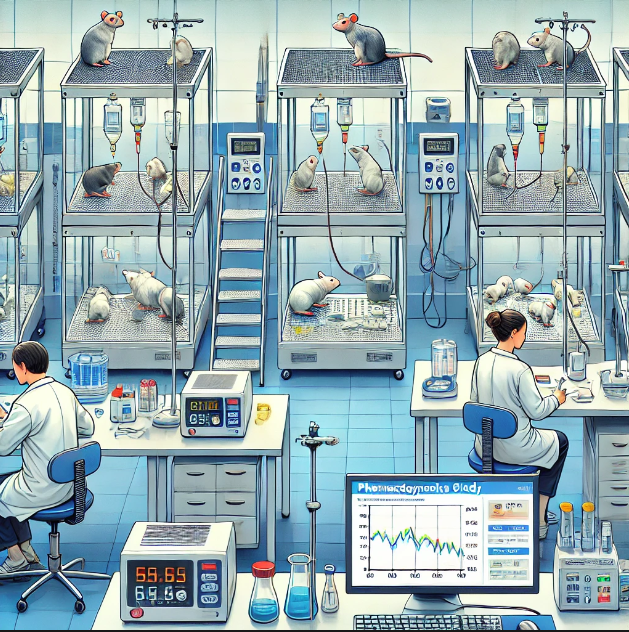drug efficacy, safety, metabolism, and toxicity
Here are some common types of pharmacology experiments performed on animals in laboratories for Pharmacodynamics PD Studies. These experiments aim to assess drug efficacy, safety, metabolism, and toxicity, as well as to understand disease mechanisms:
1. Pharmacokinetics (PK) Studies
- Objective: To understand the absorption, distribution, metabolism, and excretion (ADME) of a drug in animals.
- Procedures: Administering a drug and collecting blood, urine, and tissue samples at various intervals to determine drug concentration.
2. Pharmacodynamics (PD) Studies
- Objective: To study the biochemical and physiological effects of drugs and their mechanisms of action.
- Procedures: Measuring changes in biomarkers, heart rate, blood pressure, or behavior in response to drug treatment.
3. Toxicology Studies
- Objective: To assess the potential harmful effects of a drug or compound.
- Types:
- Acute Toxicity: Short-term exposure to determine lethal dose.
- Chronic Toxicity: Long-term exposure to evaluate cumulative effects.
- Carcinogenicity: Assessing cancer-causing potential.
- Procedures: Administering the drug over varying timeframes and examining for toxic effects on organs and tissues.
4. Safety Pharmacology Studies
- Objective: To evaluate potential adverse effects, especially on vital organs.
- Focus Areas:
- Cardiovascular: Monitoring for effects like arrhythmias.
- Central Nervous System (CNS): Testing for sedation, anxiety, or pain perception.
- Respiratory: Assessing impact on respiratory rate and lung function.
5. Efficacy Testing for Therapeutic Drugs
- Objective: To determine the effectiveness of a drug for treating specific conditions.
- Examples:
- Pain Models: Testing analgesics by measuring response in models of pain (e.g., hot plate, tail flick).
- Cancer Models: Using tumor-bearing animals to evaluate the anti-tumor effects of a drug.
- Infectious Disease Models: Testing antibiotics and antivirals in infected animals.
6. Behavioral Pharmacology
- Objective: To study the effects of drugs on behavior and psychological states.
- Types of Tests:
- Anxiety Models: Open-field test, elevated plus maze, and light/dark box for anxiety.
- Depression Models: Forced swim test and tail suspension test.
- Learning and Memory: Morris water maze and passive avoidance tests.
7. Pain and Analgesia Studies
- Objective: To evaluate the analgesic properties of drugs.
- Methods: Using mechanical, thermal, or chemical stimuli to induce pain and then assessing the animal’s response.

Metabolism and Enzyme Induction Studies
- Objective: To examine how a drug is metabolized and whether it induces certain liver enzymes.
- Procedures: Analyzing metabolites in blood and tissues, and studying enzyme induction profiles in the liver.
9. Reproductive and Developmental Toxicology
- Objective: To investigate effects on reproductive health and fetal development.
- Studies:
- Fertility Studies: Assessing impact on mating behavior and reproductive organs.
- Teratology Studies: Testing for birth defects or malformations.
- Perinatal/Postnatal Studies: Observing drug impact during pregnancy and on offspring post-birth.
10. Drug Addiction and Dependence Studies
- Objective: To understand potential for addiction or dependence.
- Procedures: Self-administration, conditioned place preference, and withdrawal symptom observation.
11. Genotoxicity and Mutagenicity Studies
- Objective: To assess potential for genetic mutations.
- Examples: Micronucleus assay, Ames test (for bacteria), and chromosome aberration tests in animal cells.
12. Immune System Studies
- Objective: To examine effects of drugs on the immune system.
- Examples: Evaluating immune response, studying inflammation, or examining autoimmune reactions.
13. Drug-Drug Interaction Studies
- Objective: To assess potential interactions with other drugs.
- Procedures: Administering a drug in combination with other drugs to study pharmacokinetic and pharmacodynamic interactions.
ADME studies in pharmacology Analgesic efficacy studies Animal pharmacology testing Anti-tumor drug testing Cancer models in pharmacology Drug efficacy animal models Drug efficacy in animals Experimental pharmacology methods Infectious disease models Pain models in animal research PD studies in animal testing Pharmacodynamics (PD) in animals Pharmacokinetics (PK) in animals Pharmacology animal studies PK studies in animals
Related Posts
Trolley for Mice and Rats Cages
November 6, 2024
admin
0
Understanding Pharmacokinetics (PK) Studies in Animals
November 11, 2024
admin
0
